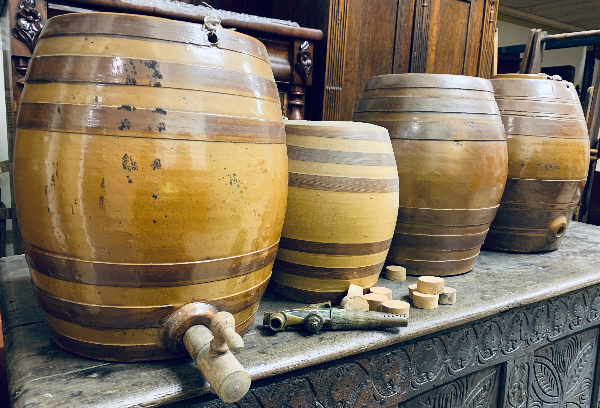
These stoneware casks are part of the Worcestershire County Museum Collection. Victorian earthenware and stoneware vessel were used to serve many alcoholic beverages, and in the case of these items, locally made cider.
Cider is a popular drink in Britain today, enjoyed as refreshment on a warm summers day or served warm on a cold winters night. It can be both a traditional, time-honoured beverage that has barely changed in centuries, and a modern tipple that comes in a vast variety of flavours. It is celebrated during the wassail in ancient orchards with folk songs and torchlight, as much as it is in the bars of the city centres. Much like our taste in clothing, your taste in cider may be very personal and specific, made possible by the enormity of choice that the drink’s long history has produced. Worcester Beer Cider and Perry Festival 2023 served nearly 6000 pints of cider so its popularity is certainly not on the wane.
At its roots, cider production links to the deep past of rural England. Whilst The Romans are credited with spreading apple orchards to norther France and Britain, it is also known that the Celts were already consuming fermented crab apple fruit before the Romans arrived on our shores. This is hardly surprising however as, unlike wine or beer, the fermentation of alcohol from fruit is a naturally occurring process that you do not have to be human to discover. There are many documentaries that show the intoxication effect of fermenting marula fruit on the animals that eat it. Apples have the same quality, as demonstrated in Sweden in 2011 when a drunken moose gorged itself on fermenting apples and had to be extracted from a tree by Gothenburg Fire and Rescue.
Cider is a drink that has associations with many places throughout England. If you can grow apples you can produce cider, hence the variety of regional terminology and dialects associated with its production. There are local speciality apple and pear varieties too, that mirror the hop varieties used by the brewing industry. Our neighbours in Herefordshire and nearby Somerset are now responsible for most of the Cider production in England, with Worcestershire, Gloucestershire, Cornwall and Kent following behind.
Times did get rough for small scale regional cider production at the end of World War II. Larger companies began to dominate the market, as farmers and small producers sold their presses and mills. As was the case for many industries, large companies amalgamated the small into their own businesses and the ancient traditions of cider making began to decline. The drink that captured the spirt of the agricultural worker, paid to work the fields in cider produced on the same farm, gave way to industrial scale production and competition. The quality cider in an earthenware costrel that would entice the best workers to harvest, had become as obsolete as the labourers themselves, replaced by the combine harvester.
Thankfully, traditional brewing and cider production has encouraged the resurgence that has accompanied many artisan products. Commercial brands are still aplenty, but there is often the option to sample something traditional as well. Cider and fruit juices can easily be prepared at home by the amateur too, making good use of local produce with a minimum of outlay. We are once again beginning to celebrate and enjoy the produce raised on our local soil.